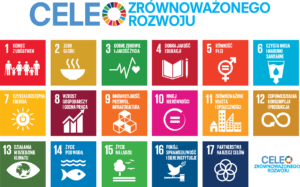Strategia biznesowa MŚP do 2030 roku jako strategia zrównoważonego rozwoju lub strategia ESG
Kiedy zaczynałam udzielać się w zarządzaniu firmą z sektora MŚP, strategia biznesowa mogła być budowana na wiele lat do przodu, bo taki był rynek. Potem się sytuacja zmieniła i do 2015 roku budowanie takiej wieloletniej strategii było bezsensowne.
Aktualnie zmieniłam zdanie. Od 2015 roku mamy Agendę 2030 Globalny Plan Działań, Globalne Cele Zrównoważonego Rozwoju (SDG) i raportowanie w układzie ESG i to jest powód zmiany mojego myślenia.
Mamy, w otoczeniu dalszym wszystkich firm, ustalone do 2030 roku Globalne Cele: 17 SDG.
Jaki to ma związek z biznesem? Z firmami MŚP?
Otóż cele te mają olbrzymi wpływ na przyszłość biznesu, są powodem zmian w regulacjach prawnych i standardach w Europie i na świecie.
Przytoczę urywek z Preambuły Agendy 2030:
“„My, narody” – tymi wzniosłymi słowami rozpoczyna się preambuła Karty Narodów Zjednoczonych. To właśnie „my, narody” wyruszamy dziś w podróż drogą, która zaprowadzi nas do 2030 r. W podróż tę wyruszamy wraz z rządami i parlamentami, strukturami Organizacji Narodów Zjednoczonych i innymi instytucjami międzynarodowymi, władzami lokalnymi, rdzenną ludnością, społeczeństwem obywatelskim, biznesem i sektorem prywatnym, środowiskiem naukowym oraz akademickim i wszystkimi ludźmi.” Koniec cytatu, wytłuszczenie dodane
 W plakacie 17 Globalnych Celów Zrównoważonego Rozwoju widzę. dużo pozytywnej energii, nadziei na lepszą przyszłość i uratowanie planety dla naszych wnuków.
W plakacie 17 Globalnych Celów Zrównoważonego Rozwoju widzę. dużo pozytywnej energii, nadziei na lepszą przyszłość i uratowanie planety dla naszych wnuków.
Nasza wspólna świadomość, Noosfera, rozwija się bardzo szybko ostatnimi czasy.
Zniszczyliśmy Biosferę i bez jej odbudowy grozi nam, ludziom tej planety, zagłada.
Skorzystajmy z tego, że Ziemia weszła w nowy kanał energetyczny w Kosmosie. Wykorzystajmy nasz rosnący potencjał do uratowania życia na planecie, do życia w harmonii z przyrodą i ludnością tej planety. Wykorzystajmy to do godnego życia.
Bardzo ważne jest nasze pozytywne myślenie o możliwości realizacji tych Globalnych Celów, wszystkich celów, do czego wszystkie MŚP namawiam.
Pytanie jak MŚP ma wdrożyć te cele?
Jak ma budować strategię do 2030 roku w oparciu o te cele?
Jak ma wdrożyć zrównoważony rozwój?
Uważam, że powinniśmy budować strategię biznesową, jako strategię zrównoważonego rozwoju, opartą o analizę Globalnych Celów i raportować corocznie jej realizację w układzie ESG.
Za 2026 rok MŚP rejestrowane na giełdzie będzie zobowiązane raportować informacje zgodnie z dyrektywą CSRD w europejskim standardzie ESRS.
Wcześniej o takie dane może zapytać MŚP każdy inwestor, kontrahent, który sam musi raportować takie informacje w swoich łańcuchach dostaw.
Strategia biznesowa. Jak MŚP ma ją zbudować?
Budowanie strategii zrównoważonego rozwoju, jako głównej strategii biznesowej, różni się technicznie od budowy zwykłej strategii biznesowej.
Po podjęciu decyzji o jej budowie, należy przemyśleć, opracować i wdrożyć Kodeks Postępowania w Biznesie wraz z Kodeksem Postępowania Dostawcy lub tylko odpowiednie OWU do umowy z dostawcami.
Należy opracować Mapę Interesariuszy, znaleźć kluczowych dla biznesu interesariuszy i tych, których wsparcie może być szansą dla biznesu. Trzeba opracować Politykę komunikacji z Interesariuszami.
W analizie strategicznej należy przeanalizować ryzyka i szanse także wynikające z wpływu na środowisko i społeczeństwo, i to także na środowisko i społeczeństwo świata.
W analizie strategicznej należy zaznajomić całą kadrę kierowniczą, a potem i pracowników, z 17 SDG, zadaniami i przemyśleć inicjatywy, które potencjalnie mogłyby wspierać realizację Globalnych Celów. Można się wspomóc np. tą stroną .
Te nowe ryzyka dodatkowo analizować trzeba z punktu widzenia lokalnych oddziaływań i globalnych oddziaływań. Mamy nową ekonomię różnie nazywaną: ekonomię wpływu, ekonomią zieloną, ekonomią oddziaływania, impact economy.
Osobiście namawiam do budowy strategii, w której firma wspiera 17 Globalnych Celów. Nauczyłam się tego na przykładzie opracowanym dla kopalni odkrywkowej przez Columbia University w Nowym Yorku.
Moim zdaniem, MŚP może wesprzeć realizację wszystkich 17 SDG.
Czy po to istnieje MMŚP, żeby wspierać 17 SDG?
Nie, ale opracowanie strategii opartej na tych Globalnych Celach może pomóc firmie przetrwać, rozwinąć się i utrzymać na rynku.
Czy raz opracowana strategia biznesowa da nam stabilny plan do 2030 roku?
Niestety. Coroczna aktualizacja jest niezbędna, bo tylko cele SDGs są do 2030 roku niezmienne. Pozostałe czynniki zmieniają się dynamicznie.
Czy w takim razie warto budować strategię biznesową do 2030 roku?
Warto, bo wchodzimy w czas wielkich zmian technologicznych i prawnych. Niektóre zawody w 2030 roku już nie będą istnieć. Świadomość naszych klientów również się zmienia.
Strategia biznesowa a zarządzanie strategią zrównoważonego rozwoju
Zarządzanie Strategią Zrównoważonego Rozwoju może się odbywać z wykorzystaniem Strategicznej Karty Wyników, w której dodajemy dodatkowe perspektywy.
Perspektywę Klienta dzielimy minimum na 3 perspektywy:
- Klient
- Środowisko
- Społeczeństwo
Ulega zmianie model biznesowy.
Powszechnie używany Model Biznesowy Canvas przybiera nowe oblicze. W literaturze można znaleźć różne propozycje wariantu tego modelu, jako odpowiednie dla zrównoważonego rozwoju. Zrobiłam kompilację różnych propozycji.